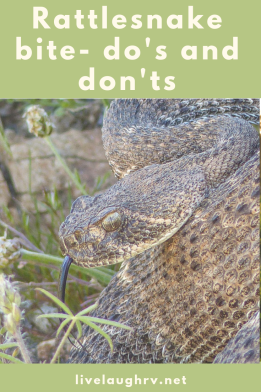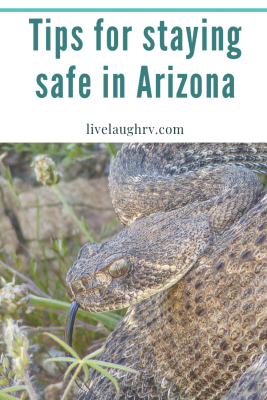Spring in the desert southwest is always enjoyable. The weather is near perfect and the wildflowers are blooming. It’s so pretty and a great time of year to visit Phoenix, Arizona but as we get further into the month of April, the Phoenix desert starts heating up. We’ve already had some days exceeding 90 degrees Fahrenheit.
Listening to the local weather report can be quite entertaining, especially when they talk about cold fronts. We have family members who live in northern Wisconsin. While our Wisconsin family remain bundled up in winter attire shoveling out from a recent snowstorm, we too suffered a cold front; gusty winds and a temperature high of only 75 degrees F. We almost couldn’t wear shorts. I guess, a cold front is a cold front, it’s all relative 😄
I assume that you aren’t exactly feeling sorry for me and my weather woes, but when I tell you who I’m likely to share the trail with while out hiking, you might feel differently. 🐍

It’s snake season but also baby season
As much as I’m loving the warm sunny weather, so do the snakes. I’m not sure I’ll ever get comfortable coming face to face with a Diamondback rattlesnake, and each snake encounter causes me to stay off the trails for a while … and may be the cause of a few more grey hairs!
Being startled by a rattlesnake sure gets my heart pounding, and I feel quite rattled as I’m sure does the rattlesnake.
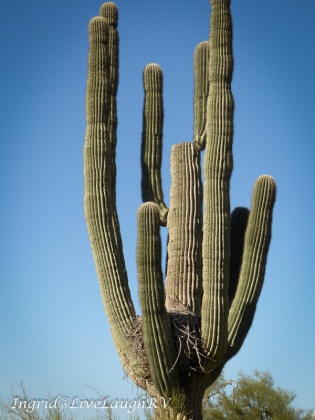
Eventually, my apprehension to hike subsides, and I’m back out hiking but choosing trails that are wide and popular with plenty of other hikers out on the trail. I’ve also learned to keep my eyes down while scanning the trail.
By choosing a popular hiking trail, it’s my hope that the activity keeps the snakes away or that someone else spots her first, which was the case in my recent diamondback rattlesnake meet up.
Two weeks ago, Al and I decided to start our hike at the Desert Vista Trailhead which is part of the Phoenix Sonoran Preserve. I’ve hiked here before and knew about a Great Horned Owl’s nest. Her nest is huge and constructed between the arms of a large saguaro cactus. Really interesting to see.
I figured by early April, momma owl most likely would be caring for her offspring, and I wanted to see if I could photograph her, or at the very least, see a little owlet.
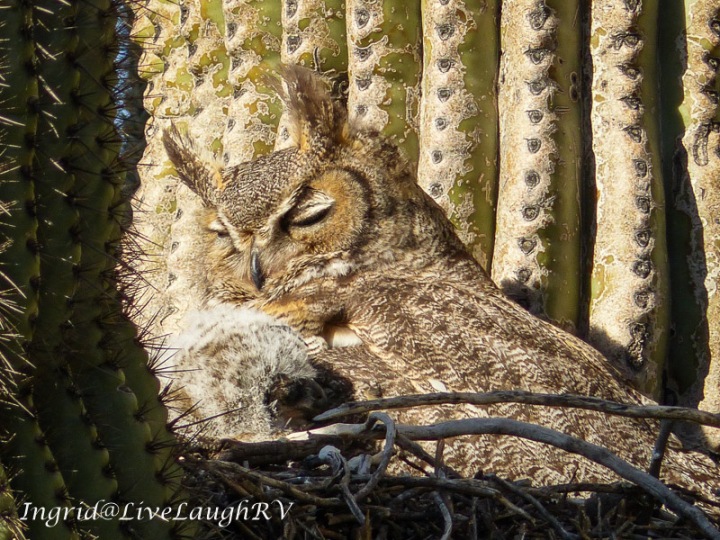
Score! Ms. Owl was pretty far away and I had to zoom in as much as possible (600mm). I wish I could’ve captured a better image of her and her owlet, but it was still fun seeing mom and baby through my zoom lens.
After a few camera clicks, we continued on our hike. As we rounded a corner, another couple hiking stopped us to warn us of a rattlesnake along the trail. Cool! I had fair warning, and therefore, wasn’t startled … this is the best scenario if you’re going to meet a rattlesnake on the trail.
What to do when you see a rattlesnake?
The first thing you do is grab your camera … okay, no you don’t. The first thing you do is step away slowly to not alarm the snake. The snake will strike if it feels threatened. If you are a safe distance away from the rattlesnake, then maybe you can take a photo or two. But keep in mind, a rattlesnake can strike about half its length and is fast. So, if you see a six-foot snake know that it can possibly strike a subject three-feet away. And when they’re coiled up, it’s hard to tell exactly how long that snake is. Always veer on the side of caution!


Arizona is home to thirteen different species of rattlesnakes. Some may rattle before striking, but not always. So, they are definitely unpredictable. Each hiker, Al and I included, walked past her quickly … giving her a wide berth, but she did rattle with each passerby. As hikers, we not only had to worry about the snake striking but also not walking too close to the Teddy Bear Cholla cactus aka jumping cholla. If you get too close to one of these cactus, a needled segment will break off and fly at your body. Crazy, huh! And the thorns are like little fishhooks … ouch!
After our diamondback rattlesnake encounter, the rest of our hike was pleasant and uneventful. And these days, I’m sticking to trails that are wide and popular. This gal doesn’t like surprises!
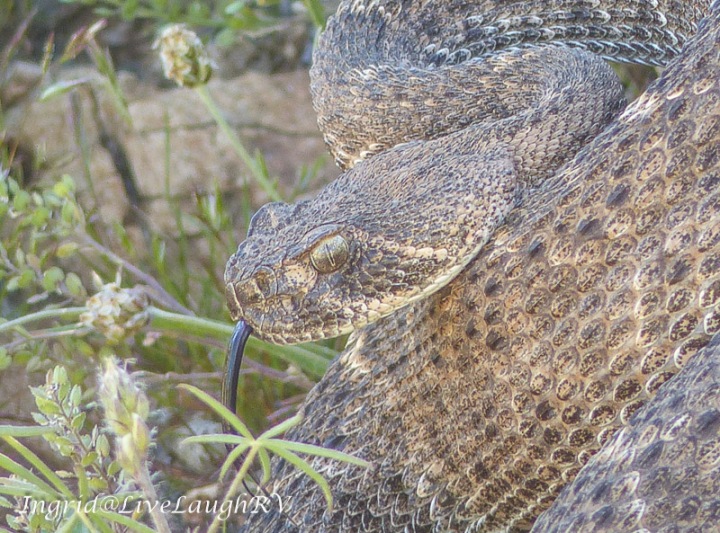
How to make your desert visit safe?
- Watch your step and be on the lookout for snakes. Rattlesnakes are known to blend in with their environments. When traveling at night, carry a flashlight to make sure every step is the right one.
- Think twice before walking through vegetation and never put your hands where you can’t see them. You could be reaching blindly into a shrub, bush, or rock where a snake may be hanging out.
- Don’t approach or provoke a snake. More than half of all rattlesnake bites are caused by provoking or approaching a snake. Keep a close eye on children and pets.
- Never make a snake feel threatened. It doesn’t want to strike you any more than you want to be bitten.

Tips if you’re bitten
DO:
- Keep the bitten area still and stay calm.
- Seek medical attention immediately.
- Remove any jewelry near the affected area in case of swelling.
- Elevate the wound area if possible.
- If you’re hiking, call 911 and if possible slowly walk to a trailhead or the nearest trail marker. Do not run. Keep body activity to a minimum to avoid the spread of venom.
DON’T:
- Don’t drive yourself to the hospital.
- Don’t use ice to cool the bite.
- Don’t cut open the wound and try to suck out the venom.
- Don’t use a tourniquet. This will cut off blood flow and the limb may be lost.
- Don’t attempt to administer your own first aid.
Most popular snakes found in the Phoenix area
Western Diamondback Rattlesnake (venomous). This is the most commonly encountered rattlesnake in the Phoenix valley and can be found anywhere where neighborhoods are near native desert habitat. They are large, aggressive, and venomous, so keep your distance and let it move on. They can be identified by the rattle, white and black striped tail, and white-lined diamond pattern on the back. Coloration is usually drab shades of brown or grey.
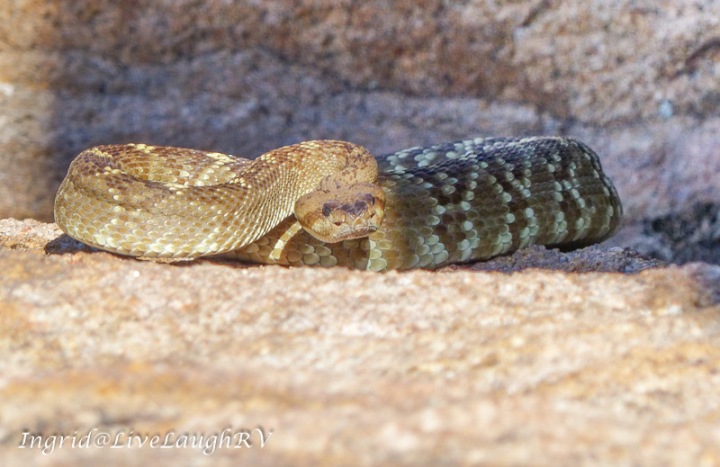
Sonoran Sidewinder (venomous). Sidewinders are small rattlesnakes that live in sandy desert areas. Most are 2 feet long or less and move with a distinctive side-winding motion. These are common in the outskirts of the Phoenix West Valley in washes or flat, open areas. They avoid rocky areas. They are easily identified by the horns that protrude over each eye, and the white and brown ribbon going down the back.
Speckled Rattlesnake (venomous). Speckled rattlesnakes live in rocky areas near mountains or hillsides. They vary in color, from a white/grey in the South Mountain and White Tanks areas, brown in North Phoenix, and orange and red going North into Cave Creek and the Anthem areas. They have a loosely banded pattern that is highly flecked to resemble granite. They’re most common in the South Mountain area.
Sonoran Gophersnake (harmless). The Sonoran Gophersnake is a large snake that can be found everywhere in the Phoenix area, even in alleyways and backyards in urban areas. These are very commonly mistaken for rattlesnakes due to a very good impersonation, which includes flattening the head, loud hissing, striking, and even a rattling tail. While they can become quite large and give a painful bite, they are otherwise completely harmless and great to have around for rodent control.

